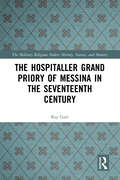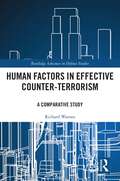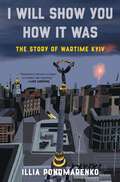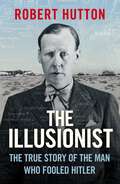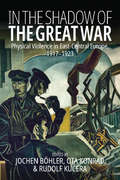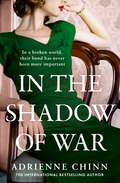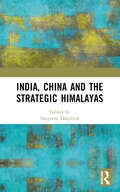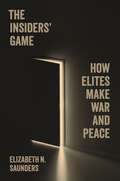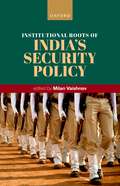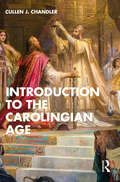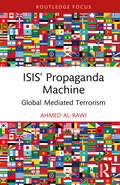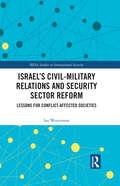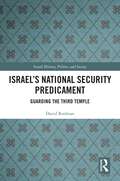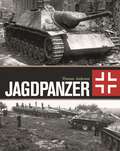- Table View
- List View
The Hospitaller Grand Priory of Messina in the Seventeenth Century (ISSN)
by Ray GattThis book details the origin of the Grand Hospitaller Priory of Messina. It discusses a breadth of themes, such as the historiography, the Hospitaller’s European commandery and Sicilian patrimony, its management and organization in the seventeenth century, its religious practices, and the prioral mansion in Messina. The final chapter includes a detailed account of the 1674 Messina insurrection against the Spanish overlords. This event plunged the priory into political chaos, fracturing it and pitting members against each other. It also shattered neutrality issues embedded in the statutes of the religion and ignoring the precepts emanating from the Convent on Malta.The Hospitaller Grand Priory of Messina in the Seventeenth Century will appeal to students and scholars alike interested in the Crusading Orders, the history of the Knights Hospitaller, and the history of Malta.
How to Lose a War: The Story of America's Intervention in Afghanistan
by Amin SaikalAn incisive, authoritative account of the West’s failures in Afghanistan, from 9/11 to the fall of Kabul In 1958, Richard Nixon described Afghanistan as “unconquerable.” On 15 August 2021, he was proven right. After twenty years of intervention, US and NATO forces retreated, enabling the Taliban to return to power. Tens of thousands were killed in the long, unwinnable war, and millions more were displaced—leaving the future of Afghanistan hanging in the balance. Leading expert Amin Saikal traces the full story of America’s intervention, from 9/11 to the present crisis. After an initial swift military strike, the US became embroiled in a drawn-out struggle to change Afghanistan but failed to achieve its aims. Saikal shows how this failure was underlined by protracted attempts to capture Osama bin Laden, an inability to secure a viable government via “democracy promotion” efforts, and lack of wider strategy in the “war on terror.” How to Lose a War offers an insightful account of one of the US’s most significant foreign policy failures—and considers its dire consequences for the people of Afghanistan.
Human Factors in Effective Counter-Terrorism: A Comparative Study (Routledge Advances in Defence Studies)
by Richard WarnesThis book seeks to provide a comparative assessment of the significance of ‘human factors’ in effective counter-terrorism. The phrase ‘human factors’ is used to describe personal relationships, individual capabilities, effective leadership, technical interface, organisational culture and the community engagement necessary to effectively minimise, counter and control the threat of terrorism. Unlike many works in the field, this book is constructed around the input of ‘experienced knowledge’ from over 170 semi-structured interviews of specialist military, policing, intelligence and security practitioners - those actors actually involved in countering terrorism. These practitioners come from seven countries – the United Kingdom, Ireland, France, Spain, Israel, Turkey and the United States – all of which have suffered over the years from different types of terrorist threat and responded with a mixture of counter-terrorist measures. Where military practitioners also discussed overseas counter-insurgency measures, that material has been included, since terrorism forms a key aspect of such wider insurgencies. The resulting interview data was analysed through a variant of ‘Grounded Theory’ to identify key emerging themes and issues, both positive and negative, relevant to ‘human factors’ in the individual countries and more generically. This book incorporates the informed operational experiences and insights of the interviewees while seeking to provide examples of successful counter-terrorist measures at the strategic, operational and tactical levels. This book will be of much interest to students of counter-terrorism, defence studies and security studies in general.
Human Factors in Effective Counter-Terrorism: A Comparative Study (Routledge Advances in Defence Studies)
by Richard WarnesThis book seeks to provide a comparative assessment of the significance of ‘human factors’ in effective counter-terrorism. The phrase ‘human factors’ is used to describe personal relationships, individual capabilities, effective leadership, technical interface, organisational culture and the community engagement necessary to effectively minimise, counter and control the threat of terrorism. Unlike many works in the field, this book is constructed around the input of ‘experienced knowledge’ from over 170 semi-structured interviews of specialist military, policing, intelligence and security practitioners - those actors actually involved in countering terrorism. These practitioners come from seven countries – the United Kingdom, Ireland, France, Spain, Israel, Turkey and the United States – all of which have suffered over the years from different types of terrorist threat and responded with a mixture of counter-terrorist measures. Where military practitioners also discussed overseas counter-insurgency measures, that material has been included, since terrorism forms a key aspect of such wider insurgencies. The resulting interview data was analysed through a variant of ‘Grounded Theory’ to identify key emerging themes and issues, both positive and negative, relevant to ‘human factors’ in the individual countries and more generically. This book incorporates the informed operational experiences and insights of the interviewees while seeking to provide examples of successful counter-terrorist measures at the strategic, operational and tactical levels. This book will be of much interest to students of counter-terrorism, defence studies and security studies in general.
I Will Show You How It Was: The Story of Wartime Kyiv
by Illia Ponomarenko"A story of searing clarity from Ukraine's frontlines of an unfathomably resilient, freedom loving people who refuse to bend to Putin's assault on truth and human life."-Nicole Perlroth“Destined to become a classic of modern war reporting.”-Luke HardingA raw, irreverent account of a young Ukrainian reporter on-the-ground as his country heroically defends itself against the Russian invasion. In late February 2022, a series of missiles and rocket strikes began falling upon Ukraine, as the Russian military barreled over the border and fanned out across the country. First they took Chernobyl, then Kherson, then Mariupol. Time stood still as the world waited for Ukraine to flatten underneath the boot of its neighbor. Meanwhile, on the front lines in the capital city, Kyiv Independent reporter Illia Ponomarenko was seeing a different story on unfold: after months-years-of waiting for this long-feared attack, Ukraine was fed up and ready to fight back. The Russians bogged down hard in combat east and west of Kyiv. They got exhausted. They screwed up logistics. They sustained heavy losses. Their unbelievably overconfident blitz was failing. I Will Show You How It Was is Illia Ponomarenko's heart-wrenching memoir of the war on his homeland, offering a fiery diatribe against Russian hypocrisy and a moving look at what is being lost. But it's also a story of pride and even elation as Ukrainian forces come together, find their mojo, and oust the invaders from Kyiv. The most powerful and personal chronicle of the war to date, I Will Show You How It Was is an exceptional literary achievement, chronicling a stunning feat of resistance and a courageous people set on a miraculous victory.
The Illusionist: The True Story of the Man Who Fooled Hitler
by Robert HuttonCairo, 1942: If you had asked a British officer who Colonel Clarke was, they would have been able to point him out: always ready with a drink and a story, he was a well-known figure in the local bars. If you then asked what he did, you would have less success. Those who knew didn't tell, and almost no one really knew at all.Clarke thought of himself as developing a new kind of weapon. Its components? Rumour, stagecraft, a sense of fun. Its target? The mind of Erwin Rommel, Hitler's greatest general. Throughout history, military commanders have sought to mislead their opponents. Dudley Clarke set out to do it on a scale no one had imagined before. Even afterwards, almost no one understood the magnitude of his achievement. Drawing on recently released documents and hugely expanding on the louche portrait of Clarke as seen in SAS: Rogue Heroes, journalist and historian Robert Hutton reveals the amazing story of Clarke's A Force, the invention of the SAS and the Commandos, and the masterful hoodwinking of the Desert Fox at the battle of El Alamein. The Illusionist tells for the first time the dazzling tale of how, at a pivotal moment in the war, British eccentricity and imagination combined to thwart the Nazis and save innumerable lives - on both sides.
In the Shadow of the Great War: Physical Violence in East-Central Europe, 1917–1923
by Jochen Böhler, Ota Konrád, and Rudolf KučeraWhether victorious or not, Central European states faced fundamental challenges after the First World War as they struggled to contain ongoing violence and forge peaceful societies. This collection explores the various forms of violence these nations confronted during this period, which effectively transformed the region into a laboratory for state-building. Employing a bottom-up approach to understanding everyday life, these studies trace the contours of individual and mass violence in the interwar era while illuminating their effects upon politics, intellectual developments, and the arts.
In the Shadow of War (The Three Fry Sisters #3)
by null Adrienne Chinn‘An emotive and engaging read’ Bestselling author Rosanna Ley One war may be over, but their fight for survival continues… For sisters Etta, Jessie and Celie Fry, the Great War and the hardships of the years that followed have taken a heavy toll. Determined to leave her painful past behind her, Etta heads to the bright lights of Hollywood whilst Jessie, determined to train as a doctor and use her skills to help others, is hampered by the men who dominate her profession. On the vast, empty plains of the Canadian prairies, Celie and her small family stand on the brink of losing everything. As whispers of a new war make their way to each sister, each must face the possibility of the unthinkable happening again… Praise for Adrienne Chinn: 'Rich, evocative and utterly immersive, this beautifully written book swept me away' Jenny Ashcroft, author of Meet Me in Bombay 'It is one of those books that you can't put down but also don't want to finish too soon!’ ⭐⭐⭐⭐⭐ 'An excellent read which once started was impossible to put down. I’m so hoping for book 4! Highly recommend this series’ ⭐⭐⭐⭐⭐ 'Brilliant storytelling. Highly recommended. I can't wait for the next one.' ⭐⭐⭐⭐⭐ 'Fabulous characters and storylines which bring in aspects of real history. Superb storytelling.’ ⭐⭐⭐⭐⭐ 'An excellent read which, once started, was impossible to put down. Highly recommend this series.’ ⭐⭐⭐⭐⭐ 'A fantastic book which kept me enthralled all the way through.’ ⭐⭐⭐⭐⭐
India, China and the Strategic Himalayas
by Sangeeta ThapliyalThis book analyses strategic discourse on the Himalayas from the perspective of India’s interests. Home to many communities, cultures, natural resources and political boundaries, it is the geopolitical landscape of the Himalayas between India and China that dominates other narratives and discourses. The traditional notion of Himalayas as India’s frontiers and buffer is challenged by China. Despite various mechanisms to address border resolution there are violations and transgressions from China. This book examines India’s responses to the new emerging challenges in the Himalayas. How the statist discourse on strategic interests incorporates people’s discourse. It provides a nuanced understanding of India’s strategic undertakings, diplomatic initiatives and development framework. This book will be a valuable addition to existing knowledge on the Himalayas between India and China. Scholars and practitioners interested in International Relations, Strategic Studies, Himalayan Studies and South Asian Studies will find it useful. Print edition not for sale in South Asia (India, Sri Lanka, Nepal, Bangladesh, Pakistan and Bhutan)
India, China and the Strategic Himalayas
This book analyses strategic discourse on the Himalayas from the perspective of India’s interests. Home to many communities, cultures, natural resources and political boundaries, it is the geopolitical landscape of the Himalayas between India and China that dominates other narratives and discourses. The traditional notion of Himalayas as India’s frontiers and buffer is challenged by China. Despite various mechanisms to address border resolution there are violations and transgressions from China. This book examines India’s responses to the new emerging challenges in the Himalayas. How the statist discourse on strategic interests incorporates people’s discourse. It provides a nuanced understanding of India’s strategic undertakings, diplomatic initiatives and development framework. This book will be a valuable addition to existing knowledge on the Himalayas between India and China. Scholars and practitioners interested in International Relations, Strategic Studies, Himalayan Studies and South Asian Studies will find it useful. Print edition not for sale in South Asia (India, Sri Lanka, Nepal, Bangladesh, Pakistan and Bhutan)
India’s Cybersecurity Policy: Evolution and Trend Analyses
by Thangjam K. SinghThis book examines India’s public policies on cybersecurity and their evolution over the past few decades. It shows how threats and vulnerabilities in the domain have forced nation-states to introduce new policies to protect digital ecosystems. It charts the process of securitisation of cyberspace by the international system from the end of the 20th century to the present day. It also explores how the domain has become of strategic interest for many states and the international bodies which eventually developed norms and policies to secure the domain.Consequently, the book discusses the evolution of cybersecurity policy at global level by great powers, middle powers, and states of concern and compares them with the Indian context. It also highlights the requirement of introducing/improving new cybersecurity guidelines to efficiently deal with emerging technologies such as 5G, Artificial Intelligence (AI), Big Data (BD), Blockchain, Internet of Things (IoT), and cryptocurrency.The book will be of great interest to scholars and researchers of cybersecurity, public policy, politics, and South Asian studies.
India’s Cybersecurity Policy: Evolution and Trend Analyses
by Thangjam K. SinghThis book examines India’s public policies on cybersecurity and their evolution over the past few decades. It shows how threats and vulnerabilities in the domain have forced nation-states to introduce new policies to protect digital ecosystems. It charts the process of securitisation of cyberspace by the international system from the end of the 20th century to the present day. It also explores how the domain has become of strategic interest for many states and the international bodies which eventually developed norms and policies to secure the domain.Consequently, the book discusses the evolution of cybersecurity policy at global level by great powers, middle powers, and states of concern and compares them with the Indian context. It also highlights the requirement of introducing/improving new cybersecurity guidelines to efficiently deal with emerging technologies such as 5G, Artificial Intelligence (AI), Big Data (BD), Blockchain, Internet of Things (IoT), and cryptocurrency.The book will be of great interest to scholars and researchers of cybersecurity, public policy, politics, and South Asian studies.
The Insiders’ Game: How Elites Make War and Peace (Princeton Studies in International History and Politics #208)
by Elizabeth N. SaundersHow elites shape the use of force in American foreign policyOne of the most widely held views of democratic leaders is that they are cautious about using military force because voters can hold them accountable, ultimately making democracies more peaceful. How, then, are leaders able to wage war in the face of popular opposition, or end conflicts when the public still supports them? The Insiders&’ Game sheds light on this enduring puzzle, arguing that the primary constraints on decisions about war and peace come from elites, not the public.Elizabeth Saunders focuses on three groups of elites—presidential advisers, legislators, and military officials—to show how the dynamics of this insiders&’ game are key to understanding the use of force in American foreign policy. She explores how elite preferences differ from those of ordinary voters, and how leaders must bargain with elites to secure their support for war. Saunders provides insights into why leaders start and prolong conflicts the public does not want, but also demonstrates how elites can force leaders to change course and end wars.Tracing presidential decisions about the use of force from the Cold War through the wars in Iraq and Afghanistan, Saunders reveals how the elite politics of war are a central feature of democracy. The Insiders&’ Game shifts the focus of democratic accountability from the voting booth to the halls of power.
The Insiders’ Game: How Elites Make War and Peace (Princeton Studies in International History and Politics #208)
by Elizabeth N. SaundersHow elites shape the use of force in American foreign policyOne of the most widely held views of democratic leaders is that they are cautious about using military force because voters can hold them accountable, ultimately making democracies more peaceful. How, then, are leaders able to wage war in the face of popular opposition, or end conflicts when the public still supports them? The Insiders&’ Game sheds light on this enduring puzzle, arguing that the primary constraints on decisions about war and peace come from elites, not the public.Elizabeth Saunders focuses on three groups of elites—presidential advisers, legislators, and military officials—to show how the dynamics of this insiders&’ game are key to understanding the use of force in American foreign policy. She explores how elite preferences differ from those of ordinary voters, and how leaders must bargain with elites to secure their support for war. Saunders provides insights into why leaders start and prolong conflicts the public does not want, but also demonstrates how elites can force leaders to change course and end wars.Tracing presidential decisions about the use of force from the Cold War through the wars in Iraq and Afghanistan, Saunders reveals how the elite politics of war are a central feature of democracy. The Insiders&’ Game shifts the focus of democratic accountability from the voting booth to the halls of power.
Institutional Roots of India's Security Policy
by Milan VaishnavIn recent years, India has asserted its desire not simply to be a balancing power but to become a leading power on the world stage. As India's economic development has steadily progressed, so too have its foreign policy and security ambitions. However, India's ability to sustain high rates of economic growth at home and project power overseas rests on unsteady state capacities. Despite widespread concerns over the severe institutional constraints that India faces, there is a lack of scholarly research on the administrative and organizational effectiveness of India's security institutions. Myriad inadequacies related to both procedure and personnel continue to hamper the Indian state's ability to perform one of its most essential functions: protecting Indians from security threats at home and abroad. Institutional Roots of India's Security Policy aims to deconstruct and interrogate disparities in India's security institutions through high-quality analytic examinations of more than a dozen foreign policy and national security institutions spread across four domains: the armed services, intelligence, border and internal security, and police and investigative agencies. A one-stop resource on India's security institutions, this volume demystifies secretive institutions that have long eluded careful scrutiny, including India's paramilitary forces, the Intelligence Bureau (IB), the Research and Analysis Wing (R&AW), and the Central Bureau of Investigation (CBI).
Introduction to the Carolingian Age
by Cullen J. ChandlerIntroduction to the Carolingian Age provides an accessible history of western Europe in the eighth and ninth centuries, when arguably a truly European civilization emerged out of the transformed, former world of the Roman Empire.Through a thematical and chronological approach, this book explores the life, family, and period of Charlemagne in a clear and informative way. The secular aristocrats, ecclesiastical figures, and scholars associated with the Carolingian dynasty feature as partners in building the empire and guiding its development, and the social and cultural lives of people from the elite to the common classes are also examined. Through an engaging narrative, this study demonstrates that by the end of the ninth century, the royal house faced a series of challenges that brought about the devolution of the empire into smaller kingdoms and the loosening of the Carolingian family’s grip on monarchy. Based on up-to-date scholarship, Introduction to the Carolingian Age offers explanations of historical developments and discussions of key historiographical debates.This book is an essential resource for both undergraduate students and general readers with an interest in the history of the Carolingian period from 750–900.
Introduction to the Carolingian Age
by Cullen J. ChandlerIntroduction to the Carolingian Age provides an accessible history of western Europe in the eighth and ninth centuries, when arguably a truly European civilization emerged out of the transformed, former world of the Roman Empire.Through a thematical and chronological approach, this book explores the life, family, and period of Charlemagne in a clear and informative way. The secular aristocrats, ecclesiastical figures, and scholars associated with the Carolingian dynasty feature as partners in building the empire and guiding its development, and the social and cultural lives of people from the elite to the common classes are also examined. Through an engaging narrative, this study demonstrates that by the end of the ninth century, the royal house faced a series of challenges that brought about the devolution of the empire into smaller kingdoms and the loosening of the Carolingian family’s grip on monarchy. Based on up-to-date scholarship, Introduction to the Carolingian Age offers explanations of historical developments and discussions of key historiographical debates.This book is an essential resource for both undergraduate students and general readers with an interest in the history of the Carolingian period from 750–900.
ISIS' Propaganda Machine: Global Mediated Terrorism
by Ahmed Al-RawiThis book examines ISIS’ media propaganda machine.The book focuses on case studies that have been largely understudied in relation to ISIS’ media production. Empirically, it offers new insights into how ISIS uses its media production to disseminate its extremist ideology by focusing on video games, educational apps, Dark Web sites, and offline billboards. The book argues that despite all the discussion about how ISIS has disappeared or even died, the terrorist group’s daily activities on the Dark Web show that they are still thriving and disseminating their propaganda in more than 20 different languages, and effectively functioning as an international news organization. Using a mixed-method research approach, the book offers a multilayered understanding of media content and fills a major gap in the literature, especially in relation to the use of educational apps and the Dark Web.This book will be of much interest to students of media and communication studies, terrorism and counterterrorism, Middle Eastern politics, and international relations.
ISIS' Propaganda Machine: Global Mediated Terrorism
by Ahmed Al-RawiThis book examines ISIS’ media propaganda machine.The book focuses on case studies that have been largely understudied in relation to ISIS’ media production. Empirically, it offers new insights into how ISIS uses its media production to disseminate its extremist ideology by focusing on video games, educational apps, Dark Web sites, and offline billboards. The book argues that despite all the discussion about how ISIS has disappeared or even died, the terrorist group’s daily activities on the Dark Web show that they are still thriving and disseminating their propaganda in more than 20 different languages, and effectively functioning as an international news organization. Using a mixed-method research approach, the book offers a multilayered understanding of media content and fills a major gap in the literature, especially in relation to the use of educational apps and the Dark Web.This book will be of much interest to students of media and communication studies, terrorism and counterterrorism, Middle Eastern politics, and international relations.
Israel’s Civil-Military Relations and Security Sector Reform: Lessons for Conflict-Affected Societies (Besa Studies In International Security Ser.)
by Ian WestermanThis book examines Israel’s civil-military relations (CMR) in order to explore alternatives to orthodox Western models of security sector reform (SSR) in post-conflict societies. This book argues that the guidelines of SSR have always tended to draw on theoretical work in the field of CMR and focus too heavily on Western, liberal democratic models of governance. Consequently, reform programs based on these guidelines, and intended for use in post-conflict and conflict-affected states, have had, at best, mixed results. The book challenges the necessity for this over-reliance on traditional Western liberal democratic solutions and instead advocates an alternative approach. It proposes that by drawing on an unconventional CMR model, that in turn references the specific context and cultural background of the particular state being subject to reform, there is a significantly higher chance of success. Drawing on a case study of Israel's CMR, the author seeks to provide practical assistance to those working in this area and considers the question of how this unorthodox CMR model might usefully inform post-conflict and conflict-affected SSR programmes. This book will be of interest to students of military studies, security studies, Israeli politics, and International Relations.
Israel’s Civil-Military Relations and Security Sector Reform: Lessons for Conflict-Affected Societies (Besa Studies In International Security Ser.)
by Ian WestermanThis book examines Israel’s civil-military relations (CMR) in order to explore alternatives to orthodox Western models of security sector reform (SSR) in post-conflict societies. This book argues that the guidelines of SSR have always tended to draw on theoretical work in the field of CMR and focus too heavily on Western, liberal democratic models of governance. Consequently, reform programs based on these guidelines, and intended for use in post-conflict and conflict-affected states, have had, at best, mixed results. The book challenges the necessity for this over-reliance on traditional Western liberal democratic solutions and instead advocates an alternative approach. It proposes that by drawing on an unconventional CMR model, that in turn references the specific context and cultural background of the particular state being subject to reform, there is a significantly higher chance of success. Drawing on a case study of Israel's CMR, the author seeks to provide practical assistance to those working in this area and considers the question of how this unorthodox CMR model might usefully inform post-conflict and conflict-affected SSR programmes. This book will be of interest to students of military studies, security studies, Israeli politics, and International Relations.
Israel's National Security Predicament: Guarding the Third Temple (Israeli History, Politics and Society)
by David RodmanThis book provides a ground-breaking assessment of the Israeli national security experience from the establishment of the country through to the present day. Seventy-five years after its establishment, the State of Israel continues to face an acute national security predicament as a result of the still unresolved Arab–Israeli conflict. This monograph offers a new framework for analyzing this experience, first exploring the crucial events of the past and present that define it, including interstate wars, asymmetrical wars, low-intensity conflicts, and developments in weapons of mass destruction. The book then probes how Israel’s evolving national security doctrine has addressed these various challenges over the years, highlighting the roles of a number of variables: deterrence, warning, and decision; strategic depth and defensible borders; the quality and quantity of fighting men and machines; intelligence; self-reliance in military matters; foreign policy; and the influence of ethnic demography, societal resilience, economic prosperity, and water security. Written in accessible, non-technical language, the book will appeal to general readers seeking an introduction to Israeli security, as well as to specialists and researchers in various fields, including Israeli history, Middle Eastern politics, and security studies.
Israel's National Security Predicament: Guarding the Third Temple (Israeli History, Politics and Society)
by David RodmanThis book provides a ground-breaking assessment of the Israeli national security experience from the establishment of the country through to the present day. Seventy-five years after its establishment, the State of Israel continues to face an acute national security predicament as a result of the still unresolved Arab–Israeli conflict. This monograph offers a new framework for analyzing this experience, first exploring the crucial events of the past and present that define it, including interstate wars, asymmetrical wars, low-intensity conflicts, and developments in weapons of mass destruction. The book then probes how Israel’s evolving national security doctrine has addressed these various challenges over the years, highlighting the roles of a number of variables: deterrence, warning, and decision; strategic depth and defensible borders; the quality and quantity of fighting men and machines; intelligence; self-reliance in military matters; foreign policy; and the influence of ethnic demography, societal resilience, economic prosperity, and water security. Written in accessible, non-technical language, the book will appeal to general readers seeking an introduction to Israeli security, as well as to specialists and researchers in various fields, including Israeli history, Middle Eastern politics, and security studies.
Italian Battle Fleet 1940–43: 'La Squadra', the pride of the Regia Marina (Fleet #6)
by Enrico CernuschiA comprehensive. illustrated account of the wartime Italian battle fleet, from its ships and technology to command structure, logistics, codebreaking and more.In the 1920s, the Italian Navy faced great challenges. Mussolini's ambitious Italy turned away from its alliance with Britain and France, and the Regia Marina faced the prospect of confronting both the French Navy and the Mediterranean Fleet of the Royal Navy. In the years leading up to World War II, the Regia Marina built and deployed a powerful battleship-led fleet – known in Italy as 'La Squadra' – intended to make the Mediterranean an Italian sea once more. In this book, Italian naval historian Enrico Cernuschi offers a fresh assessment of the wartime Italian battle fleet, based on his lifetime of primary-source research from both Italian and Allied sources. It offers a comprehensive portrait of this proud armada, how it was devised and built, and how it operated and fought. It covers a multitude of factors often overlooked, such as Italy's naval codebreakers, the fleet's logistics, and the qualities and limitations of Italian industry that supported it. The book also provides a concise account and analysis of the battle fleet's activities through the war, from major clashes such as the Battle of Calabria to lesser-known expeditions. The author's research into Italian wartime primary sources overturns some myths still commonplace in Anglo-American accounts. Illustrated with superb new artwork, maps and 3D diagrams, and featuring rare photos, this book is a fascinating account of Italy's great fleet of World War II.
Jagdpanzer
by Thomas AndersonThis highly illustrated title details the history of the Jagdpanzer, the self-propelled German tank destroyers introduced in the second half of World War II. Throughout World War II all sides grappled with how to deal with the threat of enemy armour. The German Army had adopted the 3.7cm anti-tank gun in the inter-war years. However, it was already apparent that the towed weapons lacked firepower and more powerful weapons were introduced in 1942 and 1943.By 1942, hard-pressed Panzerjäger (anti-tank) units equipped with towed anti-tank weapons fighting on the Eastern Front increasingly sought assistance from StuG-equipped assault artillery units. By late 1943 the StuG was being issued to new tank destroyer units and at the same time a dedicated Jagdpanzer (hunting tank) was ordered, based on the chassis and running gear of the PzKpfw IV.This highly illustrated study by German armour expert Thomas Anderson uses archival material and after-action reports to describe the development of the Jagdpanzer, and the many variants built on other German tank chassis. It also covers in detail how Jagdpanzer units were organized as well as their operational experience on the battlefield.
